A man goes for a walk on a windy day...what's the worst that can happen?
"Poetry is not made out of thoughts or casual fancies," the poet Ted Hughes instructs in his poetry writing handbook. "It is made out of experiences which change our bodies and spirits."
Hughes continues:
Fortunately, we do not have to have an extra-ordinary experience to produce some sort of poetry. And one poetic experience which all of us go through, whether we like it or not, is the hour-by-hour effect on us of the weather. Out of this almost everybody, at some time in their lives, can produce pieces of poetry. One of the most striking features of weather is wind. The wind, in all its phases, coming, here, going, and gone, might be said to be one of the great subjects of poetry.
From Ted Hughes's Poetry in the Making
"Ye clouds! that far above me float and pause/Whose pathless march no mortal may control..." wrote Samuel Taylor Coleridge on the eve of the French Revolution, and more than two hundred years later, Ocean Vuong's explored his adoptive homeland through wind and sky.
Weather induces the brain, wind summons the soul.
In 1860, fifteen years after he published his brilliant reimagining of traditional limericks and a year before he produced his Nonsense Alphabet, British poet, and illustrator Edward Lear (May 12, 1812 – January 29, 1888) jotted down a pleasurable comic tale A Walk on a Windy Day. Sourced by wind but told in Lear's characteristic nonsense form.

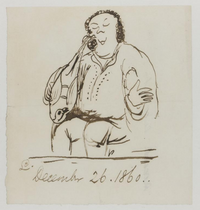 "December 26, 1860."
"December 26, 1860."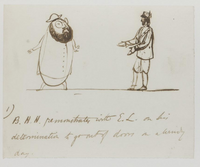 "B. H. H. remonstrates with E. L. on his determination to get out of doors on a windy day."
"B. H. H. remonstrates with E. L. on his determination to get out of doors on a windy day."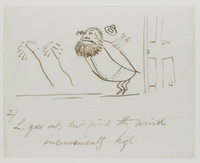 "L. goes out, but finds the wind inconveniently high."
"L. goes out, but finds the wind inconveniently high." "L. is carried off his legs into the hair [sic] all among the birds."
"L. is carried off his legs into the hair [sic] all among the birds."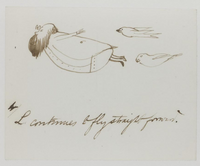 "L. continues to fly straight forward."
"L. continues to fly straight forward."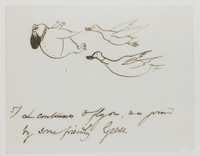 "L. continues to fly on, & is joined by some friendly geese."
"L. continues to fly on, & is joined by some friendly geese."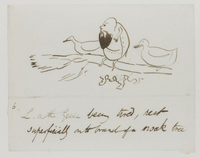 "L. & the geese being tired, rest superficially on the branch of an oak tree."
"L. & the geese being tired, rest superficially on the branch of an oak tree." "L. is gradually blown away farther & farther & farther & fluff."
"L. is gradually blown away farther & farther & farther & fluff." "The last view but one of E. L. as he appeared on the windy day of June 2, 1860."
"The last view but one of E. L. as he appeared on the windy day of June 2, 1860."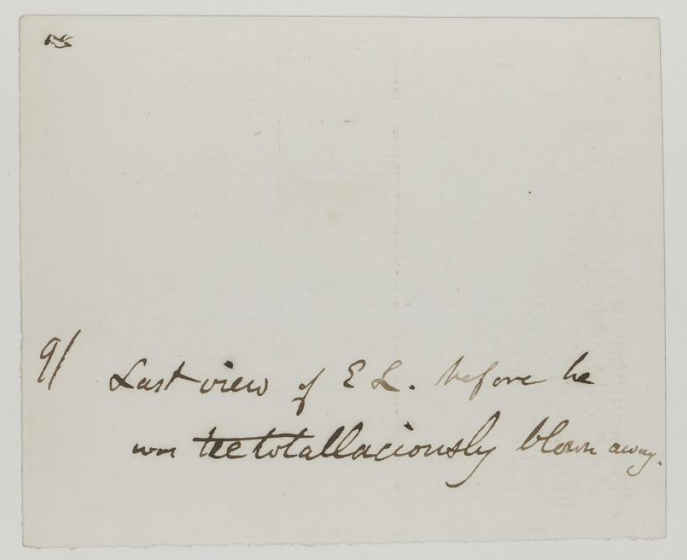 "Last view of E. L. before he was teetotallaciously blown away."
"Last view of E. L. before he was teetotallaciously blown away."Lear was a gifted illustrator who suffered from epileptic seizures, asthma, and deteriorating eyesight. He was also a closeted homosexual and bachelor. His life, also fraught with depression which he called "the morbids," was quietly isolated.
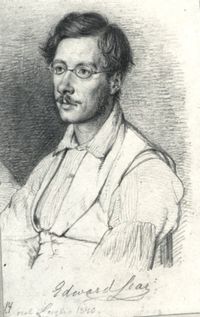 Edward Lear by Wilhelm Marstrand.
Edward Lear by Wilhelm Marstrand.When Lear published his nonsense poetry, it was wildly successful. So successful it raised issues of his identity. Lear told of overhearing a conversation that the author "Edward Lear" did not exist but was instead a pseudonym (and anagram) of the Earl of Derby, who was, in fact, Lear’s patron and whose vast menagerie Lear studied and painted. Lear interrupted the conversation to prove his existence but failed, even when he produced a with his name inscribed in it.
 Lear shows his hat to prove his identity.
Lear shows his hat to prove his identity.In the 1840s, Lear traveled and fell in love with Italy. He sketched its hills and cypress trees. It was a place he returned frequently and is now buried. I imagine that upon his return from the sun-drenched hills to his native England, Lear encountered the gale force that is British weather and was inspired to pen A Walk on a Windy Day.


